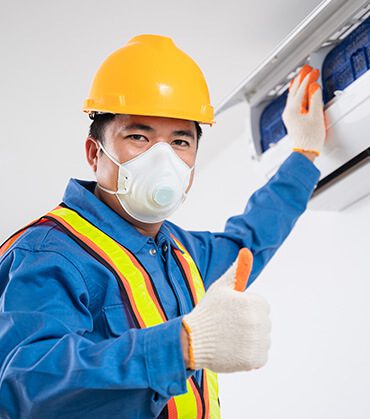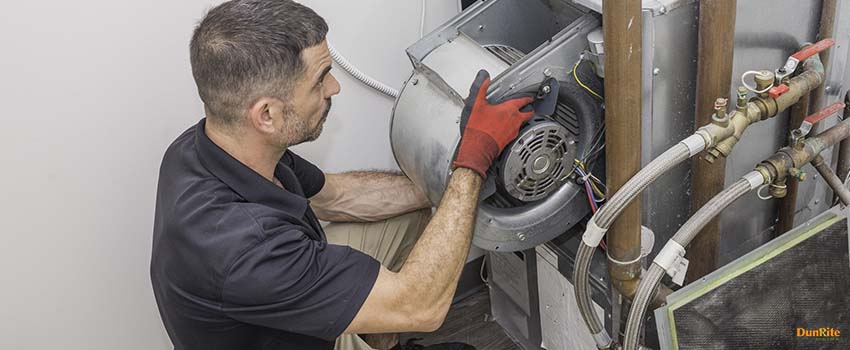Willis Carrier invented the first modern air conditioner system on July 17,1902. The invention became the catalyst for many industries that still drive our economy today. The precise control of temperature, humidity, and airflow also inspired various companies to put up businesses like indoor shopping malls and transatlantic flights as well as computer systems and servers that power the internet.
The basic principle of the cooling process is still used today, providing chilled air for everyone, especially during the summer months. Yet, not too many people know how an air conditioner works. Actually, if you examine your refrigerator closely, you’ll find that it functions much like your air conditioner. The former, however, cools only a small and limited space, while an air conditioner maintains comfortable temperatures in a larger area like your office, home, and commercial spaces.
Parts of an Air Conditioning System
The air conditioner is a central heating/cooling system that draws in warm air from the outside, removes it, and replaces it with cold air. To achieve this, the unit relies on the following parts:
1. Evaporator
This is where the air conditioning process begins as evaporator cooling coils get rid of humidity and heat from a room with the help of a cold fluid called refrigerant.
2. Blower
This part is sometimes called a fan. It helps in the circulation of air over the evaporator, eventually producing cold or chilled air.
3. Condenser
The condenser in an air conditioning unit is made up of hot coils that work on releasing collected heat.
4. Compressor
This is a pump responsible for moving the refrigerant from the evaporator to the condenser so indoor air can be chilled.
5. Fan
This blows air to the condenser so outside heat can be dissipated.
6. Filter
The filter is in charge of eliminating air particles.
7. Thermostat
The thermostat is a control system that manages the distribution of cold air.
Steps Involved in the Air Conditioning Process
Many people mistakenly believe that air conditioners work on creating cold air. This is not exactly correct. A typical air conditioning unit initially works by absorbing the heat inside your house and transferring it outside.
Specifically, here is how the entire process goes:
1. The air conditioner’s evaporator coil absorbs heat from your home.
Warm air inside your home is drawn into the evaporator through a built-in vent. This is absorbed by a cold chemical fluid called a refrigerant that consequently changes from liquid to gas. The heated air becomes cold then moves through a loop system along with the refrigerant on their way to the compressor.
During this movement, the two pass through a built-in fan or blower which pushes the cold air to an air duct. From here, the cold air is released to the target area depending on where the air conditioner was installed.
2. The compressor reduces the gas volume.
Meanwhile, as the gaseous refrigerant reaches the compressor, its volume is reduced. This is usually done by compressing the gas between two solid objects. The process increases the temperature and pressure of the refrigerant as this gets prepared for condensation.
3. The condenser transfers heat outside.
The super heated refrigerant reaches the outdoor condenser where a built-in fan will work on cooling it down. The condenser in an air conditioning unit helps dissipate the heat and move this outwards where the air eventually absorbs it. The process lowers the temperature of the refrigerant as this transforms back into cold liquid from hot gas.
4. The refrigerant returns to the evaporator to repeat the process.
After the heat has been moved to the outside, the cold refrigerant returns indoors towards the evaporator to repeat the cycle. This process continues until your home reaches the desired temperature. When this happens, the thermostat will send a signal to your air conditioner so it will turn itself off.
Types of Air Conditioners
As indoor living spaces come in many different shapes and sizes including tiny houses and large estates, residential air conditioners have also been made available in a range of styles and configurations. Presently, there are three main types of AC units, namely, split-system, packaged, and ductless. Each of these has its specific uses but all have the same parts of an air conditioning system. The best cooling type for you will depend on your location, the size of your home, the desired air conditioner size, and how you use the unit.
1. Split -System Air Conditioner
This AC type includes both an indoor and an outdoor unit. The former is usually a furnace or fan coil. It contains the evaporator and the blower fan (air handler), which circulates air throughout your home. Meanwhile, the compressor and condenser coils are both housed in the outdoor unit.
Split-system air conditioners offer a range of benefits. Among other things, they provide consistent and reliable temperature control throughout the home. They also have filters designed within the indoor air handler that clean the air as it cools.
Split-systems come in three different types. The first two include the simple single-stage system and the two-stage model, which is quieter and more efficient. Multi-stage systems, however, are the quietest of the three and are considered as money-savers.
2. Packaged Air Conditioner
Packaged systems include the compressor, blower fan, and condenser, all in one unit. These air conditioners are ideal in places where there is not enough space. They are also an excellent choice for areas with rooftop installations.
Packaged air conditioners are similar to the split systems in that they both pull warm air from your home through return air conduits and into the evaporator coil section. Eventually, cold air is released to the home via supply air ducts.
3. Ductless Air Conditioner
Because they provide cooling to specific areas of the home, ductless air conditioners can’t be considered central air systems. Also, since they do not rely on ducts for chilled air distribution, ductless types are less difficult to install.
Ductless systems are similar to the split variety as they both have at least one indoor unit and an outdoor counterpart, both of which are connected by a copper refrigerant tubing. The indoor unit can be mounted on the wall, on the ceiling, or on the floor. This allows for multiple indoor systems connected only to one outdoor unit. Ductless air conditioners are flexible systems that can be used as a zoning reference, with every room in your home having its own temperature setting depending on your comfort requirements.
Key Takeaway
Air conditioning units are staples in many residential places, but not too many homeowners are aware as to how these cooling systems actually work. From the warm air that gets sucked into the evaporator coil up to the time cold breeze is released from the air duct, there’s a lot of processes that take place inside. Yet, all of these are completed surprisingly in just a matter of minutes.
Regardless of how an air conditioner works, there’s no doubt that it is an indispensable home appliance. To ensure that they will stay with you for a long time, air conditioners need to be provided with regular and proper maintenance. On the other hand, if your unit has to be repaired for any reason, it’s best to get the services of a reputable HVAC specialist company.
For reliable air conditioner repair and installation, the only choice is DunRite Heating & Air, Inc.
Just like many home appliances, air conditioners are subject to wear and tear and will eventually suffer from some type of damage. There’s no need to worry though, because DunRite Heating & Air, Inc., is always ready to help.
With our professional HVAC San Jose team, we assure you that we can fix any problem your air conditioning unit is suffering from by taking a look at your central air conditioning system diagram. We have been in the business for half a century, and we have effectively handled innumerable AC issues. Call us now so you can see the difference in our service.



